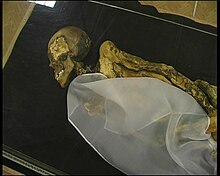Pazyryk culture: Difference between revisions
Changed "an" to "a", due to grammatical incorrectness. |
No edit summary |
||
| Line 7: | Line 7: | ||
One representative of the Pazyryk culture proved owner Y-chromosome haplogroup R1a1.<ref>[http://suyun.info/index.php?p=ancientdna Mitochondrial and Y-chromosome haplogroups extracted from historic and prehistoric human remains in Europe and related remains in Asia, arranged chronologically]</ref> |
One representative of the Pazyryk culture proved owner Y-chromosome haplogroup R1a1.<ref>[http://suyun.info/index.php?p=ancientdna Mitochondrial and Y-chromosome haplogroups extracted from historic and prehistoric human remains in Europe and related remains in Asia, arranged chronologically]</ref> |
||
Craniological studies of samples from the Pazyryk burials determined that skulls were generally of [[Europoid]] type, with some showing [[Mongoloid]] features.<ref name="Rudenko45">{{harvnb|Rudenko|1970|p=45}} "Although in general the skulls in the series are of europeoid type, there are some among them with markedly mongoloid features."</ref>The men generally being part Mongoloid and Females being Europoid.<ref>[https://books.google.co.uk/books?ei=rLbjVM6gFcjEPKOrgLgP&id=KlMhAQAAMAAJ&dq=Debets+on+the+physical+characteristics+of+the+population+in+the+Pazyryk+kurgans%2C+records+a+mixed+population.+The+men+would+seem+to+be+part+Mongoloid+and+the+women+Europoid&focus=searchwithinvolume&q=mongoloid Ars Orientalis: The Arts of Islam and the East, Volume 4]</ref> |
|||
==See also== |
==See also== |
||
Revision as of 16:41, 10 July 2015

The Pazyryk culture is a Scythian[1] Iron Age archaeological culture (c. 6th to 3rd centuries BC) identified by excavated artifacts and mummified humans found in the Siberian permafrost, in the Altay Mountains, Kazakhstan and nearby Mongolia. The mummies are buried in long barrows (or kurgans) similar to the tomb mounds of western Scythian culture in modern Ukraine. The type site are the Pazyryk burials of the Ukok Plateau.(NOVA 2007) Many artifacts and human remains have been found at this location, including the Siberian Ice Princess, indicating a flourishing culture at this location that benefited from the many trade routes and caravans of merchants passing through the area.(State Hermitage Museum 2007) The Pazyryk are considered to have had a war-like life.(Jordana 2009)
Other kurgan cemeteries associated with the culture include those of Bashadar, Tuekta, Ulandryk, Polosmak and Berel. There are so far no known sites of settlements associated with the burials, suggesting a purely nomadic lifestyle.
One representative of the Pazyryk culture proved owner Y-chromosome haplogroup R1a1.[2]
Craniological studies of samples from the Pazyryk burials determined that skulls were generally of Europoid type, with some showing Mongoloid features.[3]The men generally being part Mongoloid and Females being Europoid.[4]
See also
References
Citations
- ^ "Pazyryk". Encyclopædia Britannica Online. Encyclopædia Britannica. Retrieved March 2, 2015.
- ^ Mitochondrial and Y-chromosome haplogroups extracted from historic and prehistoric human remains in Europe and related remains in Asia, arranged chronologically
- ^ Rudenko 1970, p. 45 "Although in general the skulls in the series are of europeoid type, there are some among them with markedly mongoloid features."
- ^ Ars Orientalis: The Arts of Islam and the East, Volume 4
Sources
- Jordana, Xavier (2009). "The warriors of the steppes: osteological evidence of warfare and violence from Pazyryk tumuli in the Mongolian Altai". Journal of Archaeological Science. 36 (7): 1319–1327. doi:10.1016/j.jas.2009.01.008.
{{cite journal}}: CS1 maint: ref duplicates default (link) - NOVA (2007). "Ice Mummies: Siberian Ice Maiden". PBS - NOVA. Retrieved 2007-07-31.
- State Hermitage Museum (2007). "Prehistoric Art - Early Nomads of the Altaic Region". The Hermitage Museum. Retrieved 2007-07-31.
External links
- Nomadic Art of the Eastern Eurasian Steppes, an exhibition catalog from The Metropolitan Museum of Art (fully available online as PDF), which contains material on Pazyryk culture
